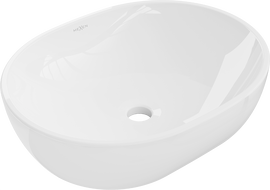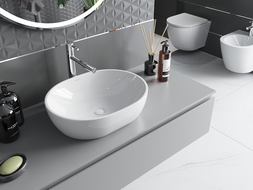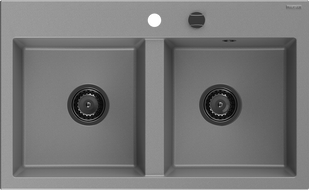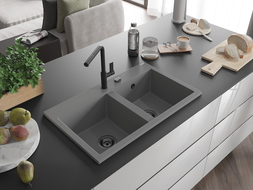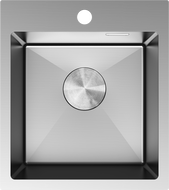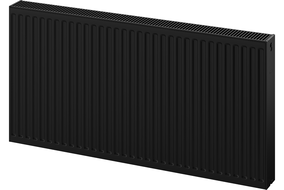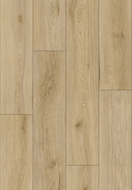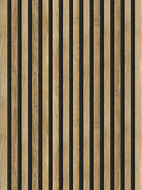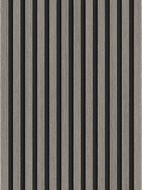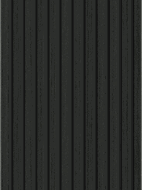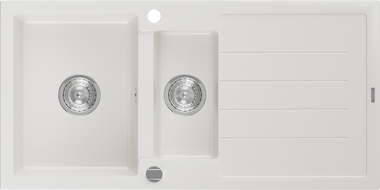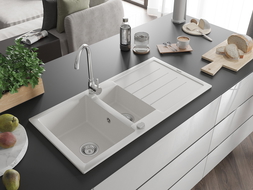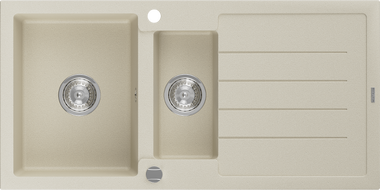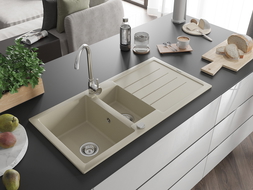
Granite sinks are known for their high durability against mechanical damage, resistance to extreme temperatures, and their incredibly aesthetic appearance. Keeping them clean does not require the use of specialist products - regularity and consistency are key to maintaining their perfect look. But what to do when stains and lime deposits appear? Let's explore how to remove streaks from granite surfaces.
How to keep a granite sink clean?
For daily cleaning of a granite sink, all you need is a sponge, dishwashing liquid, and warm water. Before cleaning, slightly wet the sponge under running water and squeeze a small amount of detergent onto its soft side. Clean the surface in small circular motions. Remember to use only the soft side of the sponge. After washing, rinse the sink with clean water and dry it with a microfiber cloth or paper towel.
Regular cleaning of the sink - why is it so important?
If you do not clean the sink regularly, small lime particles will appear on its surface. Deposits usually accumulate around the tap and on the drainer as a result of water droplets evaporating. While lime is clearly visible on dark surfaces, it may initially go unnoticed on light-colored sinks. To prevent unsightly streaks and deposits, remember to thoroughly dry the sink after each wash.
Heavily soiled granite sinks - how to clean?
If you want to remove stubborn stains from your sink surface, use a baking soda solution. After mixing baking soda and water in a 1:1 ratio, apply the paste to the entire surface, paying particular attention to stained areas. Remember to use only soft cloths and sponges for cleaning. Proceed just like when cleaning with dishwashing liquid and reach all the nooks and crannies. If the stains are particularly resistant, use products dedicated to granite surfaces. However, remember not to use strongly acidic or alkaline agents, as they can damage the surface.
Cleaning a granite sink - don't do this!
Do you want your granite sink to maintain its aesthetic look? Less is more - washing with dishwashing liquid and warm water is more than enough! Remember not to use greasy and oily products (unless for later impregnation), corrosive substances, and liquids containing acids. Hydrochloric, citric, formic, or acetic acids are often found in cleaners for limescale deposits - unfortunately, applying an acid solution to granite surfaces carries the risk of dulling them and creating difficult-to-remove streaks.
Granite sink - is it really indestructible?
It is often said that a granite sink is practically unscratchable. Certainly, when used in home conditions, it can handle almost any challenge. However, if you don't want to spend time tediously cleaning the surface, avoid pouring beetroot juice or red cabbage, wine residues, or fruit juices into the sink. The high content of dyes in products causes them to embed into the sink surface, creating difficult-to-remove stains.
By following all the above tips, you will ensure that your granite sink retains its impressive look for many years. Don't limit yourself to cleaning the surface once a week - do it every day, and you will see how easily you can extend the life of your kitchen fixtures. Systematic cleaning of the sink and thorough care using appropriate measures (such as vinegar) will extend its life and protect the granite sink's structure, keeping its surface looking as good as the day you bought it!


